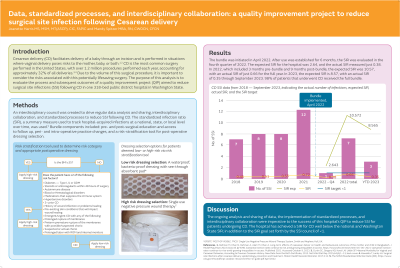Clinical Research
(CR-027) Data, standardized processes, and interdisciplinary collaboration: a quality improvement project to reduce surgical site infection following Cesarean delivery

Cesarean delivery (CD) facilitates delivery of the baby through an incision and is performed in situations where vaginal delivery poses risks to the mother, baby, or both.1,2 Over 1.2 million CDs are performed in the US annually.3
Methods:
An interdisciplinary council was created to drive regular data analysis and sharing, interdisciplinary collaboration, and standardized processes to reduce surgical site infections (SSI) following CD. The standardized infection ratio (SIR), a summary measure used to track hospital-acquired infections at a national, state, or local level over time, was used.4 Bundle components included: pre- and post-surgical education and access to follow up, peri- and intra-operative practice changes, and a risk-stratification tool for post-operative dressing selection.
Results:
The bundle was initiated in April 2022. After use was established for 6 months, the SIR was evaluated in fourth quarter 2022. The expected SIR for the hospital was 2.64, and the actual SIR measured just 0.38. In 2022, which included 3 months pre-bundle and 9 months post-bundle, the expected SIR was 10.57, with an actual SIR of just 0.66 for the full year. In 2023, the expected SIR is 8.57, with an actual SIR of 0.35 through September 2023. 98% of patients that underwent CD received the full bundle.
Discussion:
The ongoing analysis and sharing of data, the implementation of standardized processes, and interdisciplinary collaboration were imperative to the success of this hospital’s quality improvement project to reduce SSI for patients undergoing CD.

.jpeg)